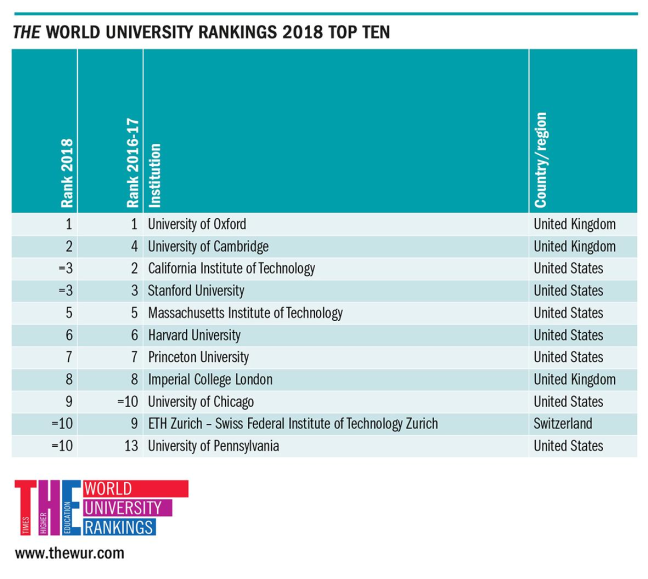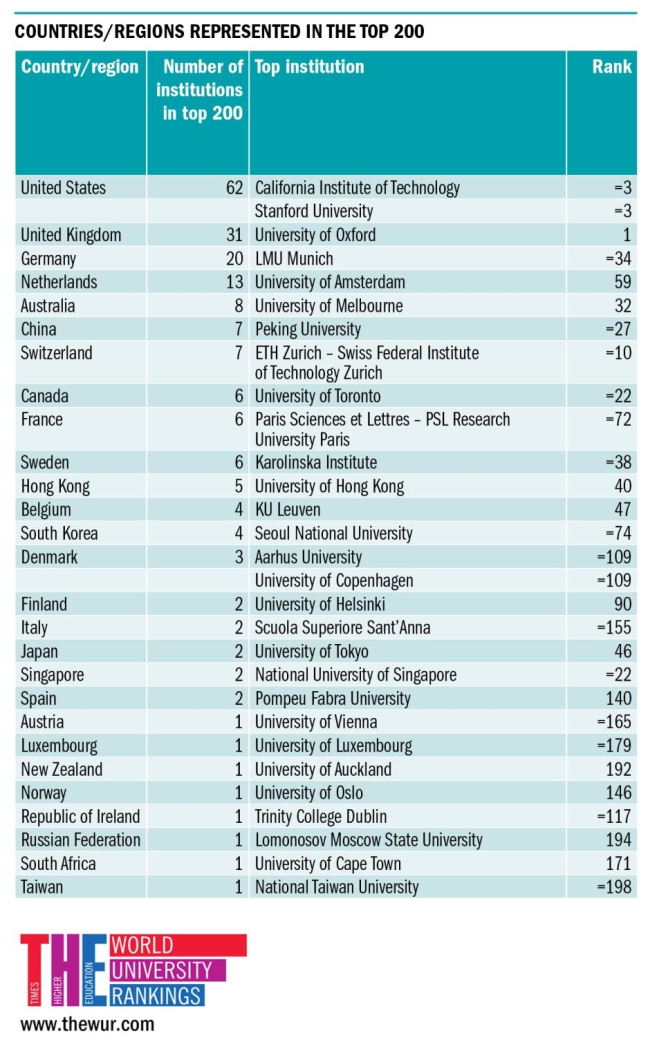
The University of Oxford and the University of Cambridge have taken the top two places in the 2018 Times Higher Education World University Rankings for the first time in the rankings’ 13-year history.
It’s the first time that the US has not had a university in first or second place. However, despite small movements at the very top of the table where Cambridge leapfrogged the California Institute of Technology and Stanford University to claim second place, the top 10 universities have held pretty firm. Only Berkeley, equal 10th last year, has departed to be replaced by the University of Pennsylvania.

If you look at just the top 200 universities (equivalent to roughly the top 1% of higher education institutions in the world), then the US, even with missing out on the top two spots, has comfortably the highest number of representatives. In fact, with 62 universities in this elite group, it has double the number of the next most represented nation, the UK with 31.

However, despite the US’s domination in terms of overall numbers, there are signs that its grip on the table is slipping. This year, 59 of those 61 US institutions in the top 200 faced a drop in their research income per academic – and the future of federal research funding under the Trump administration is in doubt. Twenty-nine of the US’ top 200 representatives dropped down the table when compared to last year.
The US is not the only country facing potential funding challenges. The UK’s position within the EU research community – a key source of funding, particularly through flagship programs such as Horizon 2020 – is at risk following the Brexit vote. Australia may suffer in future years if its government goes ahead with plans to cut funding by 2.5%, which would mean a AUS$2.8 billion fall in income across the higher education sector.
It is universities in Asia that could benefit from the uncertainty and, once again, the 2018 World University Rankings provide evidence of the continent’s rise – particularly in the East.
Mainland China has acquired three more universities in the elite top 200 this year and is now the joint 6th, most-represented nation. Peking University has risen two places to join 27th in the rankings, putting it on a par with New York University and the University of Edinburgh. Tsinghua University, meanwhile, has climbed five places to 30th, overtaking the likes of the University of Melbourne and the École Polytechnique Fédérale de Lausanne.
Asia’s top university, the National University of Singapore, has risen two places to joint 22nd. This means there are now three Asian universities in the top 30 for the first time under the current methodology.
There are warning signs for other parts of Asia, however. South Korea – which has invested heavily in higher education – does have four universities in the top 200, but three of these institutions slipped down the rankings this year. Taiwan took a knock too with its top institution – the National Taiwan University – clinging on at joint 198th.
Japan’s top institution, the University of Tokyo, has fallen from 39th to 46th place, however, both Kyoto University (joint 74th) and Osaka University (in the 201-250 band ) managed to make gains.
What is interesting when looking at the overall 2018 rankings picture is that none of the 1,000 universities ranked is considered outstanding across all five “pillars” underlying the methodology: teaching, research, citations, industry income and international outlook. Indeed not one institution makes the top 50 in all five when considered in isolation.
Achieving success relies on finding the right balance. Traditionally, the most successful universities have been located in the long-established higher education powerhouse regions: North America, Western Europe and to a lesser extent Australia. However, the 2018 results once again show that parts of Asia are certainly catching up.
The THE World University Rankings are the only global rankings that judge research-intensive universities across all their core missions: teaching, research, knowledge transfer and international outlook. The calculation of the rankings has been subject to independent audit by professional services firm PricewaterhouseCoopers (PwC).
